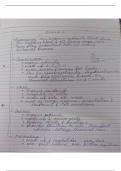Cellule Study guides, Class notes & Summaries
Looking for the best study guides, study notes and summaries about Cellule? On this page you'll find 52 study documents about Cellule.
Page 4 out of 52 results
Sort by
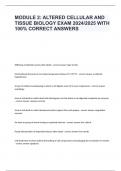
-
Module 2: Altered Cellular and Tissue Biology
- Exam (elaborations) • 5 pages • 2024
-
- $9.99
- + learn more
Stiffening of skeletal muscles after death - correct answer rigor mortis Unintentional decrease of core body temperature below 35*C (95*F) - correct answer accidental hypothermia A type of cellular housekeeping in which a cell digests some of its own components - correct answer autophagy Area of cell death in which dead cells disintegrate, but the debris is not digested completely by enzymes - correct answer caseous necrosis Area of cell death in which denatured proteins appear firm ...
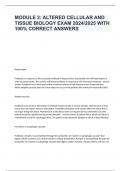
-
Module 2: Altered Cellular and Tissue Biology
- Exam (elaborations) • 5 pages • 2024
-
- $9.99
- + learn more
Hypertrophy Feedback: In response to the increased workload of hypertension, myocardial cells will hypertrophy in order to pump harder. The muscle wall becomes thicker in response to the increased workload. - correct answer A patient has an increased cardiac workload related to high blood pressure (hypertension). Which adaptive process does the nurse expect to occur in the patients left ventricular myocardial cells? Skeletal muscles. Feedback: Lack of nerve stimulation to skeletal mus...
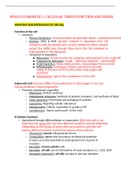
-
NUR 3125 MODULE 1: CELLULAR, TISSUE FUNCTION AND GENES,100% CORRECT
- Exam (elaborations) • 17 pages • 2023
-
- $14.99
- + learn more
NUR 3125 MODULE 1: CELLULAR, TISSUE FUNCTION AND GENES ANATOMY AND PHYSIOLOGY OF THE CELL Function of the cell • Structure o Plasma Membrane: (semi-permeable phospholipid bilayer, embedded proteins) o Nucleus: DNA & RNA (genetic material is separated from the cytoplasm with the double layer nuclear membrane which contains pores); the mRNA goes through these pores into the cytoplasm to make proteins in the ribosomes o Cytoplasm & Organelles ▪ Ribosomes: (freely found in the cytopla...
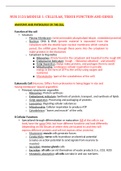
-
NUR 3125 MODULE 1: CELLULAR, TISSUE FUNCTION AND GENES,100% CORRECT
- Exam (elaborations) • 17 pages • 2023
-
- $14.99
- + learn more
NUR 3125 MODULE 1: CELLULAR, TISSUE FUNCTION AND GENES ANATOMY AND PHYSIOLOGY OF THE CELL Function of the cell • Structure o Plasma Membrane: (semi-permeable phospholipid bilayer, embedded proteins) o Nucleus: DNA & RNA (genetic material is separated from the cytoplasm with the double layer nuclear membrane which contains pores); the mRNA goes through these pores into the cytoplasm to make proteins in the ribosomes o Cytoplasm & Organelles ▪ Ribosomes: (freely found in the cytopla...
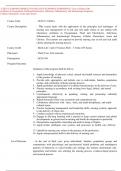
-
A SELF LEARNING MODULE ON RELATED LEARNING EXPERIENCE: Care of Clients with problems in Oxygenation, Fluid and Electrolytes, Infectious, Inflammatory and Immunologic Response, Cellular Aberrations, Acute and Chronic
- Exam (elaborations) • 31 pages • 2023
-
- $22.49
- + learn more
A SELF LEARNING MODULE ON RELATED LEARNING EXPERIENCE: Care of Clients with problems in Oxygenation, Fluid and Electrolytes, Infectious, Inflammatory and Immunologic Response, Cellular Aberrations, Acute and Chronic
This course material is for University level students. It is in simple english. The material can be understood by anyone.
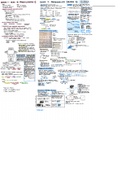
-
Human Physiology: Introduction, Macromolecules, Body Compartments, Organelles, Tissues, Energy, Reactions, and Cellular Respiration
- Class notes • 3 pages • 2023
-
- $7.99
- + learn more
Describes the 4 main keys to learning physiology: structure and function are closely related ("form fits function"), living organisms need energy, information flow coordinates body functions, and homeostasis maintains internal stability. Explains positive and negative feedback loops with images and drawings. Describes law of mass balance and how the body maintains homeostasis by local and reflex control. Macromolecules include carbs, fats, lipids, proteins, and nucleic acids. Goes over the b...
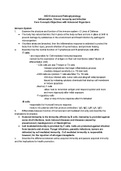
-
N5315 Advanced Pathophysiology Altered Cellular Function and Cancer Module Core Concepts and Objectives with Advanced Organizers
- Exam (elaborations) • 58 pages • 2022
-
- $11.49
- + learn more
N5315 Advanced Pathophysiology Altered Cellular Function and Cancer Module Core Concepts and Objectives with Advanced Organizers Cellular Physiology 1. Analyze the steps of the action potential. ● Sodium permeability increases, sodium ions move into the cell increasing positivity, depolarization is occurring, action potential threshold is reached as cell becomes more positive, potassium permeability increases, potassium ions leave the cell, repolarization is occurring, resting membrane...
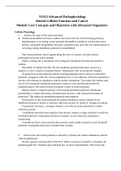
-
N5315 Advanced Pathophysiology Altered Cellular Function and Cancer Module Core Concepts and Objectives with Advanced Organizers
- Exam (elaborations) • 23 pages • 2022
-
- $11.49
- + learn more
Cellular Physiology 1. Analyze the steps of the action potential. ● Sodium permeability increases, sodium ions move into the cell increasing positivity, depolarization is occurring, action potential threshold is reached as cell becomes more positive, potassium permeability increases, potassium ions leave the cell, repolarization is occurring, resting membrane potential is reestablished. · The action potential carries signals along the nerve or muscle cell and conveys information from o...
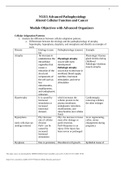
-
N5315 Advanced Pathophysiology Altered Cellular Function and Cancer Module Objectives with Advanced Organizers
- Exam (elaborations) • 7 pages • 2022
-
- $9.49
- + learn more
Module Objectives with Advanced Organizers Cellular Adaptation Patterns 1. Analyze the differences between cellular adaptation patterns. a. Differentiate between the etiology and the pathophysiology of atrophy, hypertrophy, hyperplasia, dysplasia, and metaplasia and identify an example of each

$6.50 for your textbook summary multiplied by 100 fellow students... Do the math: that's a lot of money! Don't be a thief of your own wallet and start uploading yours now. Discover all about earning on Stuvia



